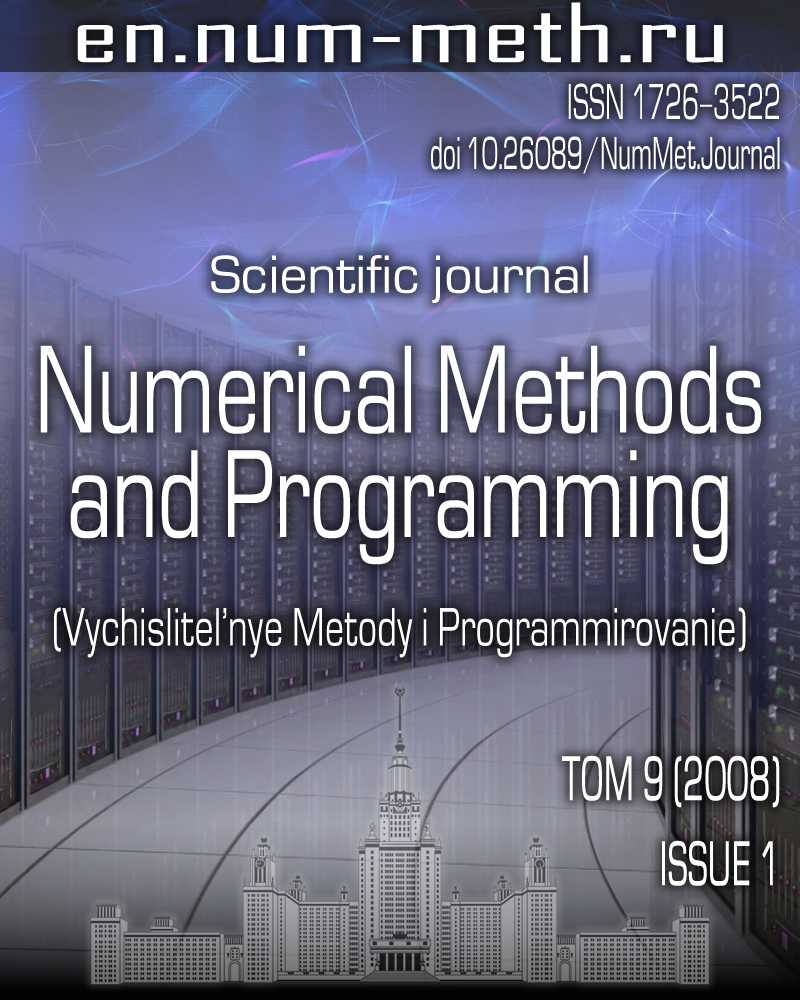Computation of contribution from the cavity effect to protein-ligand binding free energy
Keywords:
Abstract
Some results of the study of the cavitation effect, which provides an essential part of hydrophobic interactions due to the formation of protein-ligand complexes, are discussed. The change of the cavitation free energy is calculated for three protein-ligand complexes using the thermodynamic integration procedure with the original algorithm for growing the interaction potential between the cavity and the water molecules. The thermodynamic cycle consists of two stages: annihilation of the cavity of the ligand at the unbound state and its creation at the active site of the protein (the bound state). It is found that, for all the complexes under study, the values are negative and favorable for binding. The main contribution to the cavitation effect is due to the annihilation of the cavity of the ligand. All computations were made using a parallel version of the CAVE code.
Downloads
Published
Issue
Section
References
- Huang S.-Y., Zou X. An iterative knowledge-based scoring function to predict protein-ligand interactions: I. Derivation of interaction potentials //
- J. Comput. Chem. 2006. 27, N 15. 1866-1875.
- Huang S.-Y., Zou X. An iterative knowledge-based scoring function to predict protein-ligand interactions: II. Validation of the scoring function //
- J. Comput. Chem. 2006. 27, N 15. 1876-1882.
- Schwarzal S.M., Tschopp T.B., Smith J.C., Fischer S. Can the calculation of Ligand binding free energies be improved with continuum solvent electrostatics and an ideal-gas entropy correction? // J. Comput. Chem. 2002. 23, N 12. 1143-1149.
- Nikitina E., Sulimov V., Grigoriev F., Kondakova O., Luschekina S. Mixed implicit/explicit solvation models in quantum mechanical calculations of binding enthalpy for protein-ligand complexes // Int. J. Quant. Chem. 2006. 106. 1943-1964.
- Romanov A.N., Jabin S.N., Martynov Yu.B., Sulimov A.V., Grigoriev F.V., Sulimov V.B. Surface generalized born method: a simple, fast, and precise implicit solvent model beyond the Coulomb approximation // J. Phys. Chem. A Lett. 2004. 108, N 43. 9324-9328.
- Luo H., Sharp K. On the calculation of absolute macromolecular binding free energies // Proc. of the US National Academy of Sciences. 2002. 99, N 16. 10399-10404.
- Woo H.-J., Roux B. Calculation of absolute protein-ligand binding free energy from computer simulations // Proc. of the US National Academy of Sciences. 2005. 102, N 19. 6825-6830.
- Григорьев Ф.В., Лущекина С.В., Романов А.Н., Сулимов В.Б., Никитина Е.А. Расчет изменения энтропии при образовании межмолекулярного комплекса белок -лиганд в водном растворе // Биохимия. 2007. 72, № 7. 963-973.
- Carlsson J., Aqvist J. Calculations of solute and solvent entropies from molecular dynamics simulations // Phys. Chem. Chem. Phys. 2006. 8. 5385-5395.
- Ruvinsky A. Role of binding entropy in the refinement of protein-ligand docking predictions: analysis based on the use of 11 scoring functions // J. Comput. Chem. 2007. 28, N 8. 1364-1372.
- Hummer G., Garde S., Garcia A.E., Pratt L.R. New perspectives on hydrophobic effects // Chem. Phys. B. 2000. 258, N 2-3. 349-370.
- Huang D.M., Geissler P.L., Chandler D. Scaling of hydrophobic solvation free energies // J. Phys. Chem. B. 2001. 105, N 28. 6704-6709.
- Huang D.M., Chandler D. The hydrophobic effect and the influence of solute -solvent attractions // J. Phys. Chem. B. 2002. 106, N 8. 2047-2053.
- Alexandrovsky V.V., Basilevsky M.V., Leontyev I.V., Mazo M.A., Sulimov V.B. The Binomial cell model of hydrophobic solvation // J. Phys. Chem. B. 2004. 108, N 40. 15830-15840.
- Basilevsky M.V., Grigoriev F.V., Leontyev I.V., Sulimov V.B. Excluded volume effect for large and small solutes in water // J. Phys. Chem. A. 2005. 109, N 31. 6939-6946.
- Lum K., Chandler D., Weeks J.D. Hydrophobicity at small and large length scales // J. Phys. Chem. B. 1999. 103, N 22. 4570-4577.
- Floris F.M. Modeling the cavitation free energy // J. Phys. Chem. B. 2005. 109, N 50. 24061-24070.
- Floris F.M. Excess densities and equimolar surfaces for spherical cavities in water // J. Chem. Phys. 2007. 126, N 7. 074505-074512.
- Grigoriev F.V., Basilevsky M.V., Jabin S.N., Romanov A.N., Sulimov V.B. Cavitation free energy for organic molecules having various sizes and shapes // J. Phys. Chem. B. 2007. 111, N 49. 13748-13755.
- Floris F.M., Selmi M., Tani A., Tomasi J. Free energy and entropy for inserting cavities in water: comparison of Monte Carlo simulation and scaled particle theory results // J. Chem. Phys. 1997. 107, N 16. 6353-6365.
- Григорьев Ф.В., Романов А.Н., Сулимов В.Б. Двухступенчатая методика расчета свободной энергии образования субнанометровых полостей в воде методом термодинамического интегрирования // Вычислительные методы и программирование. 2007. 8, № 2. 177-184.
- Григорьев Ф.В., Базилевский М.В., Жабин С.Н., Романов А.Н., Сулимов В.Б. Расчет энергии Гиббса образования полостей в воде // Ж. Физ. Хим. 2008. 82, № 4. 1-10.
- Berman H.M., Westbrook J., Feng Z., Gilliland G., Bhat T.N., Weissig H., Shindyalov I.N., Bourne P.E. The protein data bank // Nucleic Acids Res. 2000. 28, N 1. 235-242.
- Kirkwood J.G. Theory of liquids. New York: Gordon and Breach, 1968.
- Word J.M. Asparagine and glutamine: using hydrogen atom contacts in the choice of side-chain amide orientation // J. Mol. Biol. 1999. 285. 1733-1747.
- Jarzynski C. Nonequilibrium equality for free energy differences // Phys. Rev. Lett. 1997. 78, N 1. 2690-2693. CRC handbook of chemistry and physics (78-th Edition). Boca Raton: CRC Press, 1997.


